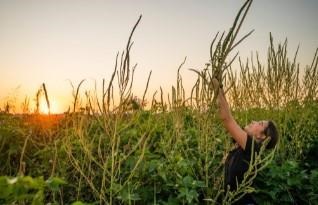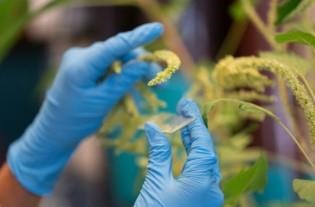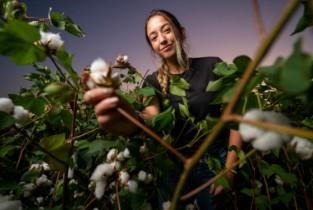Every female Palmer amaranth plant can produce over 1 million seeds that may germinate and compete with a cotton crop.

Weed science doctoral candidate Sarah Kezar examines Palmer amaranth plants on the Texas A&M AgriLife farm in Snook. (Texas A&M AgriLife photo by Sam Craft)
One doctoral student is taking on these weeds, which rob farmers through herbicide costs, yield damage or quality losses. Palmer amaranth is highly adaptable, spreading all the way up to Minnesota and Canada, and is increasingly becoming resistant to more and more herbicides.
Sarah Kezar is determined to make sure fewer Palmer amaranth plants live and produce seed, thus helping producers reap greater economic benefits. She is currently at the Department of Soil and Crop Sciences in Texas A&M’s College of Agriculture and Life Sciences.
“Sarah is a leader in our department, and we look forward to her results providing insights into controlling Palmer amaranth,” said Wayne Smith, Ph.D., associate department head and longtime cotton breeder in the Department of Soil and Crop Sciences. “Her work will have far-reaching impact as this and other pigweed species impact millions of acres in the U.S. and globally.”
Finding a research home at Texas A&M
Kezar started her college life as an animal science major in Oklahoma. A series of professors and mentors who crossed her path guided her to the Texas A&M weed science program, headed by Muthukumar Bagavathiannan, Ph.D.

A single Palmer amaranth female plant can leave behind 1 million seeds for future growth. (Texas A&M AgriLife photo by Sam Craft)
Bagavathiannan, a Texas A&M AgriLife Research weed scientist, leads a rigorous research group that is gaining national and international recognition in weed science research.
Palmer amaranth is reported to have developed resistance to eight different herbicide modes of action in the U.S., he said. His earlier research has revealed up to three-way resistance in this species in Texas. Loss of herbicide options due to weed resistance is a severe threat to the sustainability of cotton.
Regarding the threat of herbicide-resistant weeds, the goal of his research program is to understand the evolutionary biology and dynamics of herbicide resistance in weed communities. He is developing integrated weed management solutions to effectively target weed seed banks, utilizing digital technologies for weed detection, precision management and ecological studies.
“Herbicide resistance in weeds is a serious problem in many agricultural systems throughout the U.S., increasing the cost of weed control and reducing farmer profits,” Bagavathiannan said. “We are working to develop integrated herbicide-resistant weed management tactics that will both minimize input to the seed bank and thwart the evolution of weed resistance to herbicides.”
Palmer amaranth chose Sarah Kezar
Bagavathiannan leads a multi-state Palmer amaranth seed bank management project funded by Cotton Incorporated. He also leads several weed resistance management projects funded by the National Institute of Food and Agriculture, NIFA.

Sarah Kezar’s research in a cotton field is determining the importance of Palmer amaranth control in cotton late into the growing season. (Texas A&M AgriLife photo by Sam Craft)
“I didn’t choose Palmer amaranth,” Kezar said. “For my doctoral studies, Dr. Bagavathiannan presented me with a project looking at an integrated management approach of Palmer amaranth in cotton later in the season to minimize contributions to the seed bank. I said yes.”
That “yes” then led to them applying for and receiving a national Foundation for Food and Agriculture Research fellowship. The competitive program funds cohorts of graduate students over three years, using an interdisciplinary approach to career readiness. Fellows work with university and industry representatives as well as their peers to discuss urgent research and engage in professional development.
“We submitted a six-page grant proposal in the next generation crops category,” Kezar said. “My study set out to determine how Palmer amaranth impacts cotton production; how we can help producers sustain the utility of existing herbicides by developing new weed management tactics; and how that will play into managing these resistant weeds in cotton and other systems.”
Kezar was one of 22 students selected across the country. She is the only Aggie across all four current cohorts and the only weed scientist in her cohort.
“To be selected for such a high-caliber fellowship as a weed scientist, and to have my research recognized as critically important, was super awesome and I’m truly honored by that,” she said.
Cotton Incorporated and FFAR paid for her three-year dissertation program, which she is now halfway through.
Controlling Palmer amaranth escapes
Many producers will see the Palmer amaranth escapes late in the season in their fields and think “those few plants don’t matter” and let it go because the conventional weed management time window has passed, Kezar said.

Sarah Kezar, a Texas A&M College of Agriculture and Life Sciences weed science doctoral candidate works with her light box that include red and far-red light bars, to see if they can affect Palmer amaranth seed germination. (Texas A&M AgriLife photo by Sam Craft)
But the escapes do matter.
“Even if we let one female Palmer amaranth plant escape in-season control measures, she contributes to that seed bank,” Kezar said. “And next year, the farmer will have to deal with several hundreds of thousands of seeds. We can have a tremendous impact on that number by targeting those escapes in the late season.”
Kezar’s field study is looking at a multi-tactic approach to control late-season, or after layby, Palmer amaranth escapes in cotton.
“Can we spot spray with drones? Can we chop to cut off the seed head? Can we desiccate early to hit the Palmer amaranth plants before they go to seed? Can we use a gametocide and reduce the amount of pollen that can cross with the females, thus the number of seeds it contributes and the vigor of the seed that falls into the seed bank?”
Kezar said being a part of Bagavathiannan’s program has given her the ability to be curious, think outside the box and explore many options.
“I have a light box that includes red and far-red light bars to see if manipulating the red to far-red ratio can influence dormancy and germination of the seeds,” she said, explaining it is only one method they are exploring. “We know it’s going to take an integrated approach, but in the end, we also know the weed seed control methods we explore need to be applicable for producers.”
And finally, any approach must be economical to make it a viable tool for the producer.
“Again, one female Palmer amaranth, 1 million seeds,” Kezar said. “If you can make significantly fewer seed contributions, then you are inherently reducing the amount of potentially resistant seed that will directly compete with your crop the following year. If you do that year after year, you are going to greatly decrease the number of resistant weeds that are competing with your crop.”
Source : tamu.edu